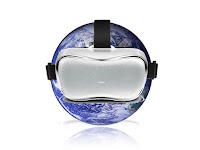The evening weather
was hot and unforgiving, the humidity beyond palpable. Not a great time to be
wearing a suit in Puerto Vallarta, I thought, nevertheless enjoying the
enchanting gourmet meal set out with certain elegance before me. I found myself
here at the well-appointed Hacienda San Angel hotel, on a hilltop above the
beautiful Guadalupe Church, not very far from the connected casitas that hosted
Richard Burton and Liz Taylor in 1964.
The occasion for my
visit was a destination wedding, a joyous gathering for the daughter of
long-time friends and frequent co-travellers. Next to me sat a world-renowned
New York City surgeon, “the” specialist in his field. He had invented and
perfected successful medical procedures that were adopted all across the world.
Yet, he was such a kind and unassuming man.
He softly nodded and asked me:
“What is it that you do?”
I responded: “I work in the field of education, with
a particular emphasis on 3D visualization and virtual reality.”
A pleasant
conversation ensued, but also a whirlwind of discovery. The
conversation led to the use of 3D surgery in his field. He saw 3D surgery as a
laudable development, but one that remained impractical. “Why?” I asked. He
explained carefully and methodically that current medical surgical procedures
were quite effective. He added that 3D surgery did, in fact, offer a number of
incremental advantages and improvements. But the price offered to hospitals
made the decision an easy
one: it wasn’t worth the money to gain some benefits on the margin. The price
for 3D surgical equipment was just too high. It just made no sense to switch to
this nascent and ‘smart’ technology. So everyone in his field, for the most
part, he explained, has stayed with traditional surgical methods. In fact, his
manner changed slightly, as a bit of soft-anger oozed out, oddly contrasting
with his normally calm demeanor.
“They can’t expect us to pay those prices,” he charged.
That, dear readers, is what we call a “pricing failure.” Join us the next two weeks for a look at the
possibility of pricing failure in the flourishing VR world.




